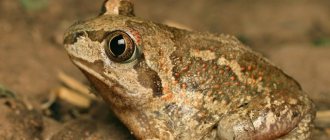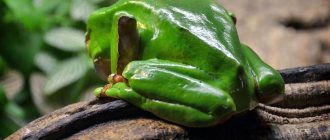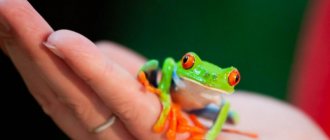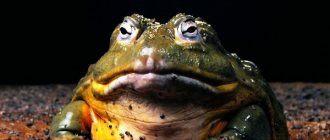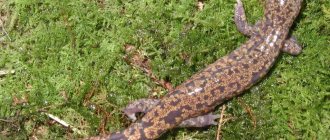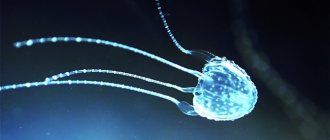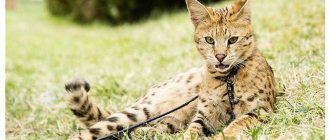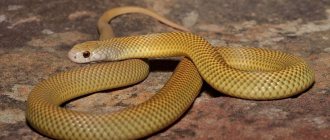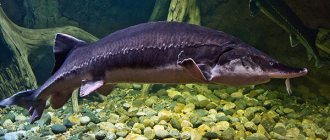Origin of the species and description
Photo: Toad aga
The aga toad belongs to the tailless amphibians of the toad family. This is a large family that includes many species. The classification of this family is quite confusing, since not all creatures called toads can actually be classified in this group. For example, there are midwife toads, nosed toads, frog-shaped toads, which belong to the families of round-tongues, Limnodynastis and Rhinoprinis. The appearance of different types of toads varies greatly.
The easiest way to identify how they differ from frogs is:
- toads have less developed hind limbs. Accordingly, toads jump worse and mostly move with slow small steps and crawling;
- in most cases, toads prefer moisture, frogs can live in the ground and in dry places;
- the body of toads is short and heavy with short massive shoulders;
- often toads are covered with tubercles, which are called warts, while frogs are smooth;
- Toads have a horizontal pupil;
- most often the ear glands behind the eyes are clearly visible.
Toads can be of completely different sizes: from 20 mm (Harlequin Guiana) to 220 mm (Blomberg's toad). Their diet and lifestyle also vary, but toads are generally nocturnal as they face a variety of predators during the day. Despite the fact that toads live near bodies of water, they are considered terrestrial or semi-terrestrial creatures. Most types of toads need water to reproduce, where they lay their eggs.
It is generally accepted that toads feed on small invertebrates - worms, insects, snails, etc. But especially large representatives of the family are also capable of eating animals: mice, birds, snakes and many other small creatures. At the same time, the stomachs of toads quickly adapt to digesting new food.
How do frogs appear?
In the spring, the female frog lays eggs. These eggs are called caviar. A frog egg looks like a small eye: inside a round white sac there is a tiny black dot. This point grows very quickly, and after a while a small tadpole can already be distinguished.
Interesting materials:
What should be the portion? What should the temperature of a diesel engine be? What should be the temperature for sleeping? What should be the temperature of the Priora engine? What should the air conditioner temperature be in summer? What should the heating temperature be? What should the temperature of the heating riser be? What temperature should the soup be? What should your body temperature be in the evening? What should be the coolant temperature in the apartment?
Appearance and features
Photo: Poisonous toad aga
The aga toad is a colorful representative of its family. It is one of the largest toads and one of the largest representatives of amphibians (only the Blomerga toad and the Goliath frog are larger). The body length can reach 24 cm, although rare individuals larger than this size have also been encountered. The amphibian weighs more than a kilogram, but males are always smaller than females.
The skin of the aga toad, like that of other toads, is covered with keratinized warts and growths. Thanks to these growths, the skin becomes stronger and it is not so easy for birds like a stork or a heron to bite through it. Toads have pronounced growths above their eyes that perform a protective function - they protect their eyes from dust and solar radiation.
Video: Toad aha
As a rule, the color of the toad is uniform - it does not need excessive camouflage. It is dark green with an admixture of brown or brown, which becomes slightly lighter in the abdomen and mouth. But in some habitats, toads acquire camouflage spots. The skin may be milky white with light green streaks, similar to the spots of a leopard. Or, on the contrary, the toad becomes darker and acquires black stripes running from the eyes along the lateral lines of the back.
The parotid glands are located on the sides of the eyes, closer to the back. But the frog has difficulty hearing, since the glands are not focused on hearing, but on producing a poisonous secretion. It repels predators and can kill some small enemies if it enters the body. Like many toads, the aga toad has a horizontal pupil, but it is much wider, causing the eyes to appear overly large.
Interesting fact: The venom of the aga toad was extracted to kill predatory pests.
The toad's legs are short and massive, and it moves slowly. There are no membranes on the front toes, but on the hind toes they are still preserved and have not been reduced. This toad is also distinguished from others by its massive head and very wide body with a convex belly.
Now you know whether the aga toad is poisonous or not. Let's see where she lives.
Long-legged litoria
Perhaps this beauty will be able to compete even with the frog princess. Unfortunately, it can only be found in New Guinea and Australia. It has quite impressive dimensions: maximum length is 14 cm.
Females are often larger than males. They have a bright green color. They live mainly in the forest in trees; the long-legged litoria , although sometimes they descend to the ground for prey. They are active at night.
Where does the aga toad live?
Photo: Aha toad in nature
The natural habitat of the aga toad is the areas near the Rio Grande rivers (Texas), central Amazonia, and northeastern Peru.
But to destroy insect pests, the aga toad was artificially introduced into the following areas:
- east coast of Australia;
- Queensled East;
- New South Wales coast;
- south Florida;
- Papua New Guinea;
- Philippine Islands;
- Ogasawara Islands in Japan;
- Ryukyu Islands;
- Caribbean Islands;
- Pacific Islands, including Hawaii and Fiji.
Aga easily took root in new lands, since it can adapt to temperatures from 5 to 40 degrees Celsius. It can be found both among the sands far from bodies of water, and in the tropics, on the coast and in marshy areas. Also, the aga toad survives well in slightly salty water, which is unusual for toads in general. In Hawaii, it was nicknamed the “sea toad” (Bufo marinus).
The peculiarity of Aga is that her skin became so keratinized and hardened that it began to exchange gas poorly. Therefore, the toad's lungs are better developed than those of other members of the family and, therefore, the toad can tolerate up to 50 percent of water loss from the body. Aghi toads do not build shelters for themselves, but find something new every time - in crevices, hollows of trees, under stones, in abandoned rodent burrows, etc. During the day they spend time in the shelter, and at night they go hunting.
Description of the gray toad
Gray toads are the largest toads in Europe. The body length of the common toad exceeds 80 millimeters; the size of females can reach 200 millimeters.
The body is squat and wide. The paws end in short toes. Males do not have resonators. The eyes are orange with horizontal black pupils.
The skin of gray toads is lumpy and dry, so their bodies do not dry out when they are at a great distance from a body of water.
The body color of the common toad changes at different times of the year, depending on age and gender. The color can be olive, gray, brown, terracotta and sand.
What does the aga toad eat?
Photo: Dangerous toad aha
Aghi toads are unusual in that they are omnivores. The usual diet includes spiders, crustaceans, all kinds of flying and land insects, including poisonous bees and beetles, centipedes, cockroaches, locusts, snails and ants.
But it can feed on vertebrates and even mammals:
- small frogs and toads;
- mice and other rodents;
- snakes, including poisonous ones;
- lizards;
- birds and eggs of birds, amphibians, reptiles;
- carrion and refuse;
- crabs, jellyfish, cephalopods;
- Sometimes aga toads can eat other members of their species. Cannibalism is not uncommon among toads.
Interesting fact: Toads cannot control the amount of food they eat and are not able to bite off food into pieces - they always swallow it whole. Therefore, sometimes dead toads are found with half the snake in the stomach and the other half outside; the toads simply suffocate, unable to eat such large prey.
Baby aga toads feed on small worms and crustaceans, daphnia, cyclops and plant food. They can also eat other, smaller babies. The agu toad is sometimes kept as a pet. In this case, it is fed a balanced diet so that the toad lives a long and healthy life.
The diet includes:
- protein insects – crickets, locusts, larvae;
- dead baby mice, hamsters. They may even be pubescent;
- additional feed with vitamins, especially calcium;
- fruit flies and small bloodworms for growing toads.
Slingshot changeable
It is also called the Brazilian slingshot . These frogs live exclusively in South America. They reach a length of 20 cm. They have a rather terrifying appearance, with horns and a crest growing on their heads. The color resembles camouflage: green, brown with dark spots, blurred contours.
Variable slingshots have an aggressive character. Known for their excellent appetite. Birds, rats and even... relatives are used. Frogs are not embarrassed even by the fact that the prey is larger than them. There are frequent cases of death from suffocation, the slingshot can neither swallow nor spit out its lunch.
Features of character and lifestyle
Photo: Big toad aha
The aga toad, like other toads, is a nocturnal amphibian. During the day she looks for prey, and since she eats almost everything that fits into her mouth, she never has problems with nutrition. The shelter of the agi toad is a hole, hole, crevice or depression in which it hides throughout the day.
Aga hunts using camouflage. It hides in the grass or merges with sand or pebbles, freezes and waits for something edible to appear in the nearest radius. It grabs prey in the same way as other toads - by throwing out its long tongue. An insect or small animal sticks to the tongue and quickly ends up in the mouth of the omnivorous toad.
If a toad encounters a large predator, it takes a defensive position. For protection, it strives to swell in size as much as possible, filling its chest pouches with air, and also rises on outstretched legs. If a predator, seeing such a large toad, does not get scared and does not run away, then it is ready to use its poison.
By exposing her poison glands to her enemy, she quickly shrinks them, shooting poison over a short distance. Such a shot sometimes reaches one meter - this is enough to hit a predator. If it gets on the mucous membrane of the eye, the poison can temporarily blind a large animal, and kill a small one altogether. When the aga releases poison, its back is covered with a white, thick liquid, which also has a small concentration of poison.
Aga does not know how to chase prey and moves in small jumps, and at the slightest drop in temperature it becomes lethargic and moves only when necessary. In dry weather, aga toads prefer to sit out in damp shelters - during this period they starve and are prone to cannibalism. Sometimes the aga toad can burrow into damp soil to absorb moisture - so that only the top of its head sticks out.
Fun fact: Toads molt, and the Aha is no exception. She climbs into her shelter, inflates herself, and waits for the skin on her back to burst. Then the skin itself begins to move away from the body to the head, and then the aga toad eats it on its own.
Yeah - a local disaster
Aga leads a nocturnal lifestyle, and during the day prefers to hide in shelters.
The giant toad is ready to eat almost anything as long as it fits in its mouth: insects, worms, spiders, lizards, snakes, small mammals, and will not even refuse to try household waste.
The aga protects itself from predators with poison, which it can spray at a distance of up to two meters. This often ends badly for the attacker: even crocodiles die after eating an aga toad! If an aha toad collides with a snake, it swells, becoming significantly larger.
Agi toads have been known since time immemorial as insatiable omnivorous predators, eating not only insects, but also any other animals that they are able to swallow. These qualities influenced their choice as a natural way to control the cane beetle, which was causing significant losses to the Australian sugar industry. But from a biological means of combating crop pests, the aga toad has turned into a real disaster, an “ecological nightmare”, a biological weapon aimed at destroying the Australian fauna.
Social structure and reproduction
Photo: Toad aga
Aga toads are predominantly solitary, but can live in small groups; Sometimes 3-4 individuals of either sex settle in one hole - this is how the toads maintain moisture. But in the absence of drought, they prefer to divide the territory. In general, the territory of one agi toad is about 32 square meters, although it can reach 2-3 thousand meters. They do not protect their own borders and freely cross others.
The mating season does not have a strict time frame: the main thing is that the water temperature is above 25 degrees Celsius. The males begin to loudly scream invitingly, and this scream can continue for several days. Sometimes they forget to eat, which greatly exhausts them.
The female comes to the male at night. Toads do not have any mating games other than singing, so the process of fertilization occurs quickly: the female releases eggs, and the male fertilizes them. In this case, the male, who is much smaller than the female, can sit on her for several days until she begins to spawn.
In one season, an adult can lay from 8 to 35 thousand eggs, and most of them will be fertilized. Sometimes the female and male eat most of them themselves. One female can be fertilized by several males. The eggs are collected in clusters and attached to plants or trees near the water, and after this the male and female do not care about future offspring.
Interesting fact: In warm climates, females can spawn several times a year.
The eggs hatch in 24-72 hours. Tadpoles reach sexual maturity by one year; the exact lifespan of toads in the wild is unknown. Under home care they can live up to 10-13 years.
Listen to the voice of the gray toad
Each female lays 600-4000 eggs. The clutch looks like long cords, which females wrap around snags, stones and vegetation in the water. Incubation lasts 10 days. Newborn larvae reach 26 millimeters in length. Tadpoles gather in numerous schools.
Tadpoles grow for 2-3 months, after which they leave the pond. Young toads reach 1 centimeter in length. Puberty in common toads occurs at 3-4 years.
Tadpoles are afraid of strong vibrations and splashes of water.
Natural enemies of the agi toad
Photo: Poisonous toad aga
The agi toad has many enemies, although it is quite protected.
The main predators that hunt toads are:
- medium-sized crocodiles - they are attracted by the large size of the agi toad, and they are also immune to its poison. Most often, baby crocodiles feast on the toad;
- lobsters;
- water and land rats;
- crows;
- herons, storks, and cranes are also immune to toad poison;
- dragonfly nymphs eat agi toad tadpoles because they have no poison;
- water beetles also prey on tadpoles;
- turtles;
- non-venomous snakes.
Interesting fact: Not all predators that want to feast on the aga toad survive a collision with this amphibian. The toad defends itself with the help of poisonous glands, and sometimes the predator attacking it itself becomes a victim and food for the toad.
Basically, predators eat only the toad's tongue because of its nutritional value, and the carcass itself repels them with its smell. In addition, hard skin is poorly digested by many predators, and some are not able to bite through it at all. It is easiest to eat the toad's belly, since it is soft and not protected by keratinized warts, but its internal organs are poisonous, so not many predators can afford this approach.
Top 10 largest frogs and toads in the world
City residents most likely do not remember the existence of frogs; they have more important things to do, and children even imagine these amphibians exclusively as fairy-tale characters.
But lucky people who often travel outside the city probably see frogs often. But they rarely evoke joyful emotions in anyone. Many people are disgusted by frogs, and some are even afraid of them. Yes, there are those who still believe that if you touch a toad, warts will appear on your hands.
Although our ordinary “average” frogs look pretty cute. These are miniature creatures and excellent jumpers. Their croaking has a positive effect on the human body. It is even called healing. But there is a wide variety of frog species in the world, some of which reach gigantic sizes.
If you are interested in this topic or just like to learn something new, read our article. We recommend you our list of the 10 largest frogs in the world: a ranking of large and heavy toads that look very scary.
